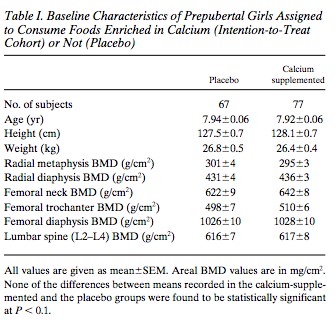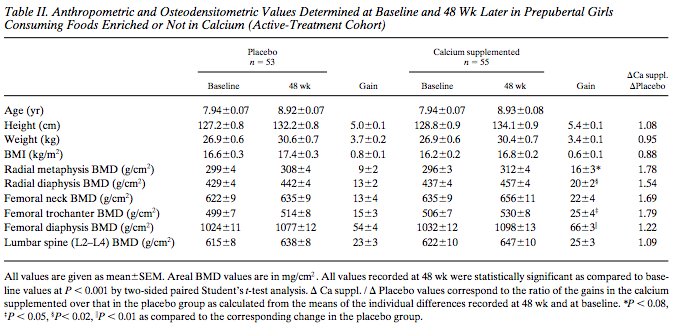Calcium Enriched Foods Like Milk Do Seem To Make Young Kids Taller
There has been so much debate over whether high calcium level or calcium enriched foods like milk actually makes kids grow taller. We went back and forth on this issue maybe 3-4 times before, and we had concluded that the most likely answer is that common food items like milk seems to have a positive, but small correlation to increased statural height increases in developing children.
We also previously looked at other common long held beliefs on children growth and lifestyle choices. We looked at the effects of coffee consumption and stunted growth, smoking and stunted growth, and even masturbation and stunted growth. Our conclusions for each are 1. No, 2. Most definitely, 3. No, respectively.
Here is a study I found which seems to finally put the nail in the coffin on the debate on milk and calcium. There are of course always some caveats.
1. The study was performed on girls who did not reach menarche yet.
 Notice the difference is around 0.6 cms, which may not seem like a lot but statistical analysis shows that the difference can NOT be just due to random chance but is starting to become statistically significant.
Notice the difference is around 0.6 cms, which may not seem like a lot but statistical analysis shows that the difference can NOT be just due to random chance but is starting to become statistically significant.
Now, the results seem to go directly against other scientific studies, like the one below
Of course, both of the studies were done on pre-pubertal kids. That is probably the key factor which explains why there is discrepancies.
Here is something important to take away: Multiple studies show that the human body can only retain about 1200-1500 mg of Calcium per day before any more increase in Ca has no effect.
For at least girls that are 7-9 years old, getting even an extra 800-900 mg of Ca per day is not enough to have the right effect for bone mass increases. When the increased Ca intake reaches the 1100-1200 mg per day mark, then the effect starts to show, but it is somewhat mild.
Note that fact that the greatest differences was in the experimental subgroup of test subjects who were given what is known as spontaneous low-calcium enriched foods. (Personally, I am not sure that that even suggests. Haven’t slept well last night.)
The researchers state two interesting facts.
The spontaneous low-calcium sub-group seemed to get most of their height in the appendicular skeleton aka bones in the torso but NOT in the axial skeletal region (which are the bones in the limbs, like leg and arms). The exact region where the bones grew larger was in the lumbar region, the L2-L4 area.
The sub-group who got the most results also had X-Rays done to show that the middle region of their femur became wider too. At this point, I can’t make any significant connections between the metaphyseal region of the femur increasing in width and the mid-lumbar vertebral bones increasing. There seems to very little difference between the placebo group and the calcium intake group on the proximal end of the femur.
It might also be useful to also look up the study “Double Blind Controlled Calcium Supplementation and Bone Mineral Accretion in Children Accustomed to a Low Calcium Diet“ by Lee and Leung
Important Note: Since the beginning of the research on the website, I have had proposed a theory that our dietary intake and habits can change our height only in the appendicular skeletal region aka torso, but won’t do much for our leg length. The length of our legs/arms seems to be much more determined by our genetics, and not by childhood dietary habits.
This was due to my analysis on the body shape of the swimmer Michael Phelps, who has a disproportionally long torso to leg length and used to consume large amounts of food as a teenager. When we compare the body proportions of a Michael Phelps to a Wilt Chamberlain or Shaquille O’Neal, we notice that for the latter two, all of their height seems to be coming from their legs, specifically femurs. Shaq is genetically pre-disposed to tall stature, since both his mother and grandfather on his mother’s side was huge. Wilt, I don’t know. He was a true genetic freak and a most likely a statistical anomaly, just like Angus MacAskill, coming along once every billion people.
This study seems to kind of validate my theory, in a sort of tangental way.


For a child who has actual nutritional deficiencies in multiple nutrients, do you think that could affect limb length or just torso?